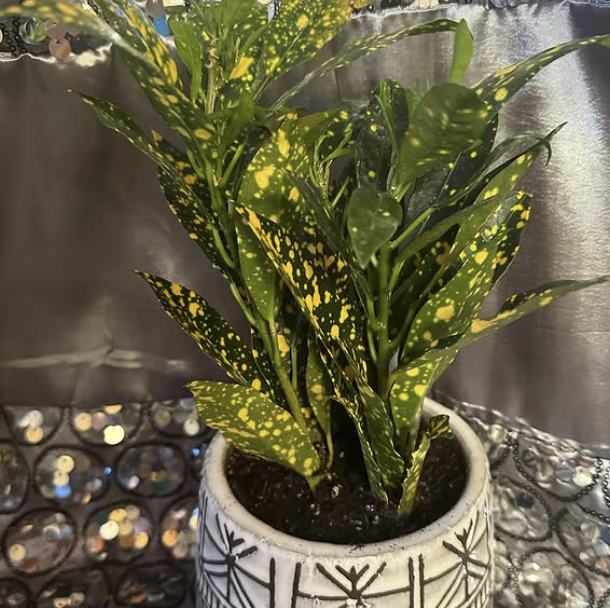The Croton Gold Dust plant (Codiaeum variegatum ‘Gold Dust’) is a stunning tropical plant known for its vibrant foliage and yellow spots that resemble splashes of gold.
It’s a popular choice among plant lovers for adding a pop of color to any indoor or outdoor space.
With proper care, this evergreen shrub can thrive and bring life to your home. Here’s everything you need to know about caring for this beautiful plant.
How to Identify
The Croton Gold Dust plant stands out with its green leaves dotted with bright yellow spots, giving it a unique appearance. The leaves are thick, leathery, and glossy, growing in an oval or elliptical shape. This plant is often mistaken for other croton plants, but the distinctive gold-flecked pattern makes it easily recognizable.
Size
The Croton Gold Dust typically grows to 3-6 feet tall indoors and can spread about 2-4 feet wide. Outdoors, in its native tropical climates like Southeast Asia and the Pacific Islands, it can grow even larger, reaching up to 10 feet tall.
The Different Types
While Codiaeum variegatum ‘Gold Dust’ is one variety, other croton plants come in various patterns and colors. These include:
- Petra Croton: Known for its multicolored leaves in red, orange, and yellow.
- Mammy Croton: Features curly, colorful foliage.
- Banana Croton: Has long, narrow leaves with green and yellow streaks.
Light
The Croton Gold Dust plant thrives in bright indirect light. While it can handle some partial shade, too little light can cause the vibrant colors to fade. Avoid placing it in direct sunlight, as this can scorch its leaves. A south-facing window with filtered light is ideal.
Water
This tropical plant prefers moist soil, but overwatering can lead to root rot. Allow the top inch of soil to dry out before watering again. During the growing season (spring and summer), it may require more frequent watering, while in the winter months, reduce the watering routine. Always ensure the pot has drainage holes to prevent waterlogging.
Temperature
The Croton Gold Dust plant thrives in warm temperatures between 65°F and 80°F. Avoid exposing it to cold drafts or temperatures below 60°F, as this can cause leaf drop or damage to the plant. Keeping the plant in a stable environment is key to healthy growth.
Humidity
This plant loves high humidity and thrives in conditions similar to its native tropical environment. To maintain the required humidity levels, try:
- Regular misting with a damp cloth.
- Using a humidity tray or placing a small humidifier nearby.
- Grouping it with other indoor plants to create a microclimate.
Soil
The Croton Gold Dust prefers well-draining soil rich in organic matter. A mix of regular potting soil with added peat moss or coarse sand works well. Ensure the soil retains enough moisture but doesn’t become soggy.
Fertilizer
Feed your plant with a balanced liquid fertilizer every 2-4 weeks during the growing season. Cut back on fertilizing during the winter months when the plant’s growth slows. Over-fertilizing can harm the plant, so always follow the recommended dosage on the fertilizer package.
Potting
Choose a pot with drainage holes to prevent excess water from pooling at the bottom of the pot. Repot the plant every 2-3 years or when the root ball outgrows the container. Use a slightly larger pot to allow for healthy growth.
Where to Place It in a Home
The Croton Gold Dust plant makes an excellent accent in:
- Living rooms or bedrooms with bright light.
- Kitchens or bathrooms where humidity levels are naturally higher.
- Near a south-facing window, but keep it away from much direct sun.
Pruning
Regular pruning helps maintain the plant’s shape and encourages new growth. Remove any dead leaves or brown tips with clean scissors. Pruning also prevents the plant from becoming leggy.
Propagation
The Croton Gold Dust is easy to propagate through stem cuttings:
- Cut a healthy stem with at least one leaf node.
- Place the cutting in a glass of water or directly into moist soil.
- Keep it in a warm, humid area with bright indirect light.
- Roots should develop within a couple of weeks.
Pests
Common pests include:
- Spider mites: These tiny creatures can cause yellowing leaves and webbing. Use neem oil or insecticidal soap.
- Scale insects: Wipe them off with a damp cloth or treat with a horticultural spray.
Diseases
The most common disease is root rot, caused by overwatering. To prevent this, ensure proper soil moisture and use pots with good drainage.
Is It Toxic?
The Croton Gold Dust plant is toxic to pets and humans if ingested. It can also cause skin irritation, so handle it with care, especially when pruning.
Common Issues and How to Fix
- Yellow leaves: Often caused by excess water or poor water quality. Adjust your watering routine.
- Leaf drop: May result from sudden changes in temperature or environment. Keep the plant in a stable environment.
- Fading colors: Caused by little light. Move the plant to a brighter location with indirect sunlight.
Difficulty Level
The Croton Gold Dust plant is moderately easy to care for, making it suitable for plant enthusiasts who are ready to step up from beginner-level plants. With the right care, it rewards you with its striking foliage and vibrant colors.
Frequently Asked Questions (FAQ)
1. Why are my Croton Gold Dust plant leaves falling off?
Leaf drop is a common issue with Croton Gold Dust plants and can occur due to:
- Sudden changes in temperature or environment, such as moving the plant.
- Cold drafts or exposure to temperatures below 60°F.
- Underwatering or overwatering, disrupting the plant’s moisture balance.
To fix this, keep your plant in a stable environment, ensure proper watering, and avoid placing it near vents or drafty windows.
2. Why does my Croton Gold Dust plant have thin leaves?
Thin leaves can indicate:
- Lack of light: Ensure the plant is in bright indirect light or near a south-facing window.
- Nutrient deficiencies: Feed the plant with a balanced liquid fertilizer during the growing season.
- Humidity issues: Increase humidity levels using a humidity tray or regular misting.
3. How to propagate Croton Gold Dust plant?
The best way to propagate a Croton Gold Dust plant is through stem cuttings:
- Select a healthy stem with at least one leaf node.
- Cut just below the node using clean scissors.
- Place the cutting in a glass of water or directly into moist soil.
- Keep the cutting in bright indirect light and maintain high humidity levels.
Roots typically develop within a couple of weeks.
4. Can the Croton Gold Dust plant grow in water?
Yes, Croton Gold Dust plants can temporarily grow in water for propagation purposes, but they thrive best in well-draining soil for long-term growth. Ensure to change the clean water every few days to prevent bacterial buildup.
5. Is Croton Gold Dust plant toxic to cats?
Yes, the Croton Gold Dust plant is toxic to cats and other pets if ingested. Symptoms include vomiting, drooling, and stomach upset. Place the plant out of reach of pets or consider pet-safe alternatives if you have curious animals.
6. Why are the leaves of my Croton Gold Dust plant turning yellow?
Yellowing leaves can result from:
- Overwatering, leading to root rot.
- Poor water quality, such as heavy reliance on tap water.
- Nutrient deficiencies.
Adjust your watering routine, use distilled water, and fertilize during the growing season.
7. Can I place my Croton Gold Dust plant outdoors?
Yes, the Croton Gold Dust plant can be placed outdoors in tropical climates or during warm weather, but only in partial shade or indirect light. Avoid exposing it to much direct sun or temperatures below 60°F.
8. How do I make my Croton Gold Dust plant bushier?
To promote healthy growth and a bushier appearance:
- Prune the plant regularly using clean tools to encourage new growth.
- Ensure it gets bright light and proper nutrients.
- Use stem cuttings to fill gaps by planting them back into the soil around the parent plant.
9. How do I revive a drooping Croton Gold Dust plant?
Drooping can occur due to underwatering, low humidity, or root stress.
- Check the soil moisture and water thoroughly if the soil feels dry.
- Increase humidity levels through misting or a tray of water.
- Inspect the roots for root rot and repot if necessary.
10. What pests commonly affect Croton Gold Dust plants?
The most common pests include:
- Spider mites, which cause webbing and tiny silver specks.
- Scale insects, which leave sticky residue on the leaves.
Treat infestations with neem oil or insecticidal soap, and wipe the leaves with a damp cloth regularly to prevent buildup.

